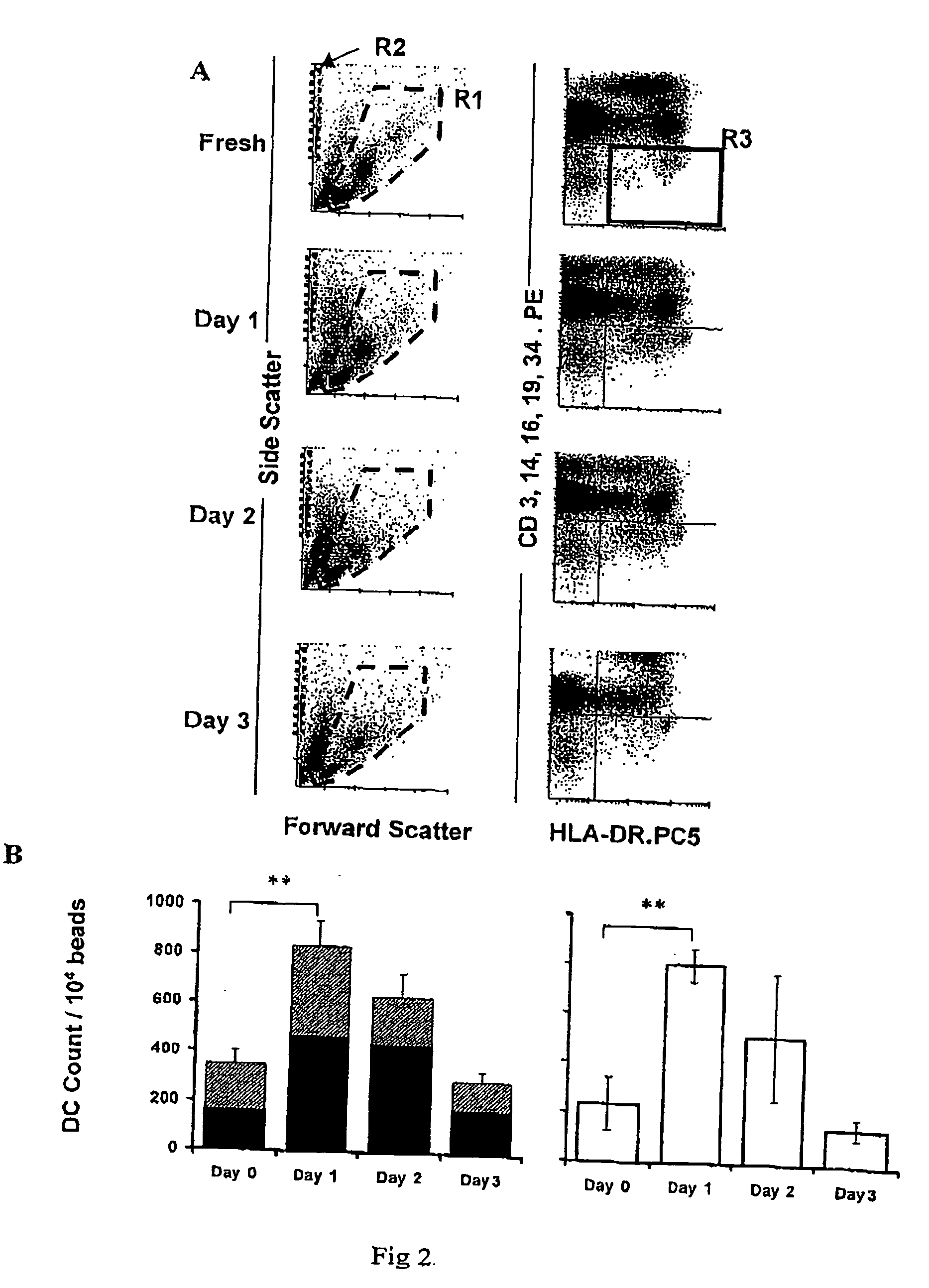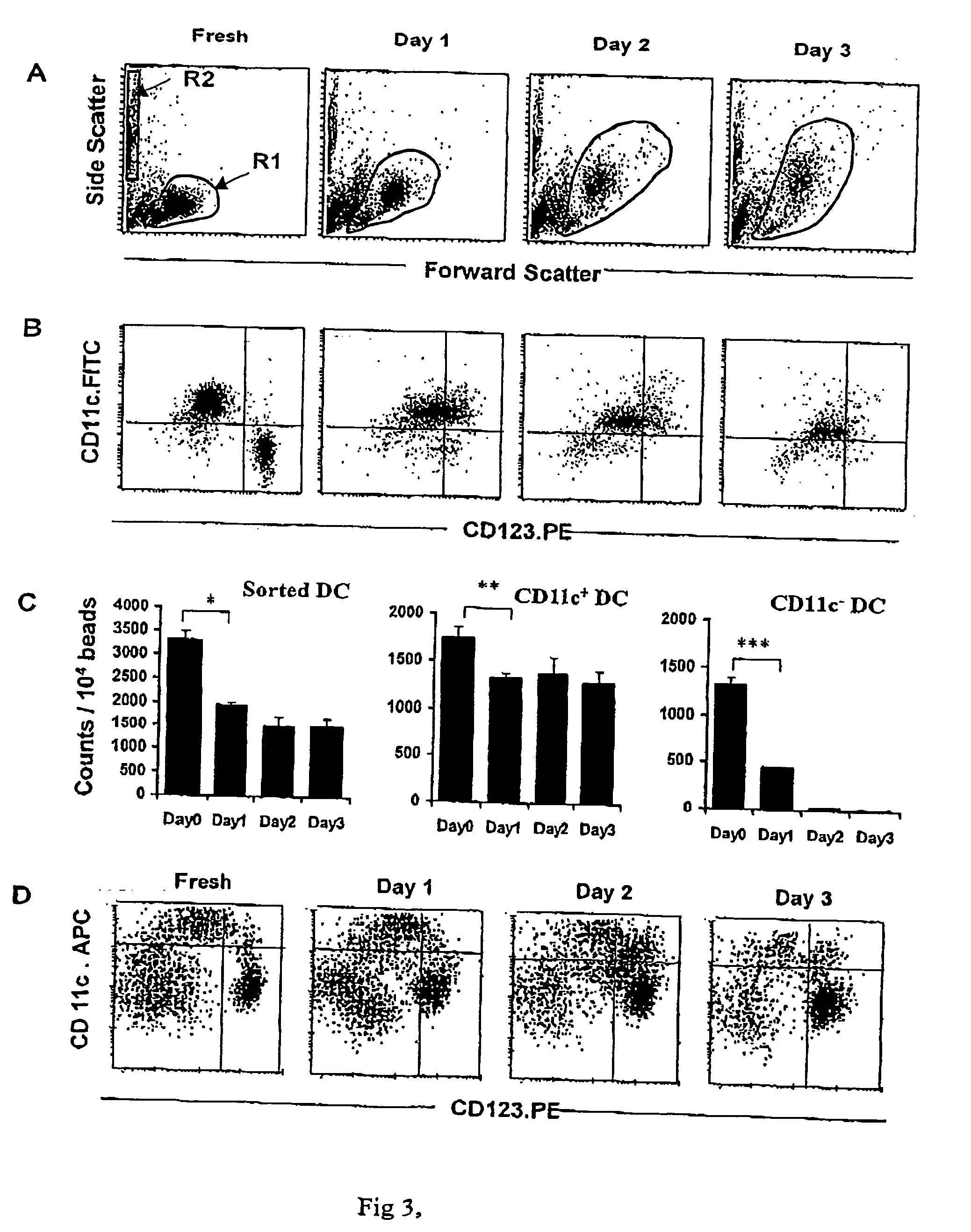Method for culturing dendritic cells
a dendrite cell and cell technology, applied in the field of cell culture process and to cells produced therein, can solve problems such as substantial loss of numbers
- Summary
- Abstract
- Description
- Claims
- Application Information
AI Technical Summary
Benefits of technology
Problems solved by technology
Method used
Image
Examples
example 1
Spontaneous Generation and Survival of Blood Dendritic Cells in Mononuclear Cell Culture Without Exogenous Cytokines
Monoclonal Antibodies and Reagents
[0084] The following monoclonal antibodies (mAbs) were used: PE-conjugated CD3, CD14, CD16, CD19, CD34, CD7, CD80, and CD11c were obtained from Becton Dickinson (BD) (San Jose, Calif.); CD86, CD123, IgG1, and IgG2b isotype control were purchased from PharMingen (San Diego, Calif.); CD20, CD56, CD40, and CD83 from Coulter-Immunotech (Marseille, France); and CD64 from Serotec (Oxford, UK). FITC-conjugated CD11c was purchased from Serotec; CD2 from Coulter-Immunotech; and cutaneous leukocyte antigen (CLA) from PharMingen. PE.Cy5 (PE.Cy5)-conjugated HLA-DR from Coulter-Immunotech, and IgG1 isotype control from PharMingen; APC-conjugated CD11c and IgG1 isotype control tom BD; unconjugated mAbs—CD3 (OKT3), CD11b (OKM1) were obtained from the American Type Tissue Collection (ATTC, Rockville, Md.); CD16 (HuNK2), CD19 (FMC63) were gifts from...
example 2
Blood DCs Survive in Cultured PBMC Without Exogenous Cytokines
[0097] Blood DCs were defined within PBMC by two-color flow cytometric analysis as HLA-DR+ cells that were lineage (CD3, CD14, CD16, CD19, and CD34) negative. Sorted blood DCs survived poorly in vitro when isolated from the PBMC environment, even when cultured with the cytokines GM-CSF and IL-3 as has been experienced before (Kohrgruber N, Halanek N, Groger M, et al. J Immunol. 1999;163:3250-3259;Dzionek A, Fuchs A, Schmidt P, et al. J Immunol. 2000;165:6037-6046). However, it was found that when kept in contact with the other PBMC, the DCs survived for at least 3 days, in vitro, without the addition of exogenous cytokines (FIG. 1A). The relative percentage of Lin− HLA-DR+ DCs in PBMC was the same at the end of a 3-day culture as at its initiation (n=10). The Lin− HLA-DR+ DCs in cultured PBMC appeared to separate into discrete HLA-DRhi and HLA-DRlo populations compared to the more homogeneous profile obtained when examin...
example 3
TruCOUNT™ Analysis Quantifies Rise of Absolute DC Counts in Cultured PBMC
[0099] The definite but variable increase in the percentage of DCs in PBMC noted after overnight (16-24 hour) culture (n=10) was investigated further. To assess whether the increase in number reflected an increase in absolute DCs or differential survival with respect to the other PBMC populations in culture, TruCOUNT™ beads (FIG. 2A) were used to obtain absolute DC counts in 8 further experiments. The TruCOUNT™ analysis confirmed a significant rise in absolute counts of Lin− HLA-DR+ events after the overnight culture period (plo DC population increased by 235%±77% (SEM) compared with 150%±45% (SEM) in the HLA-DRhi population (FIG. 2B left).
[0100] To exclude the possibility that DC or DC precursor proliferation during the culture period was responsible for the increase, fresh PBMC were irradiated (3000 Gy), then cultured and analyzed, in parallel with their non-irradiated controls, again using TruCOUNT™ beads....
PUM
| Property | Measurement | Unit |
|---|---|---|
| pH | aaaaa | aaaaa |
| total volume | aaaaa | aaaaa |
| total volume | aaaaa | aaaaa |
Abstract
Description
Claims
Application Information
 Login to View More
Login to View More - R&D Engineer
- R&D Manager
- IP Professional
- Industry Leading Data Capabilities
- Powerful AI technology
- Patent DNA Extraction
Browse by: Latest US Patents, China's latest patents, Technical Efficacy Thesaurus, Application Domain, Technology Topic, Popular Technical Reports.
© 2024 PatSnap. All rights reserved.Legal|Privacy policy|Modern Slavery Act Transparency Statement|Sitemap|About US| Contact US: help@patsnap.com










